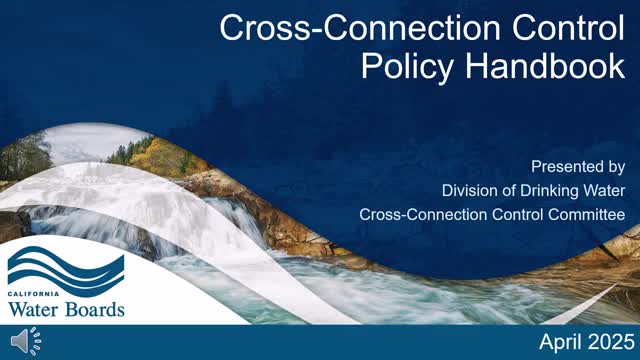California Water Board unveils Cross Connection Control Policy Handbook for public water systems
April 25, 2025 | State Water Resources Control Board, Boards and Commissions, Executive, California
Thanks to Scribe from Workplace AI and Family Portal , all articles about California are free for you to enjoy throughout 2025!

This article was created by AI using a video recording of the meeting. It summarizes the key points discussed, but for full details and context, please refer to the video of the full meeting. Link to Full Meeting
The CCCPH, which has been in development since 2017, was officially adopted on December 19, 2023, following extensive stakeholder engagement, including workshops and public hearings. This comprehensive handbook arose from Assembly Bill 1671, which mandated the establishment of standards for backflow protection and cross connection control. Another legislative measure, Assembly Bill 1180, further expanded the handbook's scope to include provisions for recycled water use.
During the meeting, key topics were discussed, including the handbook's ten core program requirements and the development of a cross connection control plan, which consists of 13 specific items that must be submitted to the State Water Board. The presentation emphasized that while the training provided valuable insights, it was not a substitute for the handbook itself, urging attendees to refer to the latest version for complete details.
The handbook aims to protect public health by ensuring that public water supplies remain uncontaminated by non-potable substances. Resources for further information were also shared, including links to the EPA's Cross Connection Control Manual and the California Plumbing Code, which contains relevant plumbing requirements.
As California continues to prioritize water safety, the CCCPH stands as a vital tool for public water systems, ensuring compliance and promoting best practices in cross connection control. The meeting concluded with an invitation for stakeholders to engage with the State Water Board for any specific inquiries related to their water systems, reinforcing the collaborative effort to maintain safe drinking water across the state.
Converted from CCCPH Training Video for Public Water Systems meeting on April 25, 2025
Link to Full Meeting
Comments
View full meeting
This article is based on a recent meeting—watch the full video and explore the complete transcript for deeper insights into the discussion.
View full meeting


